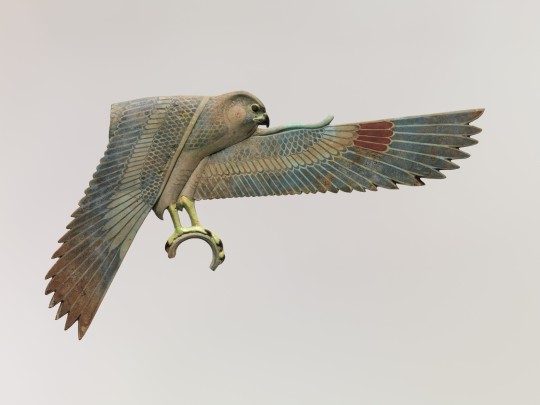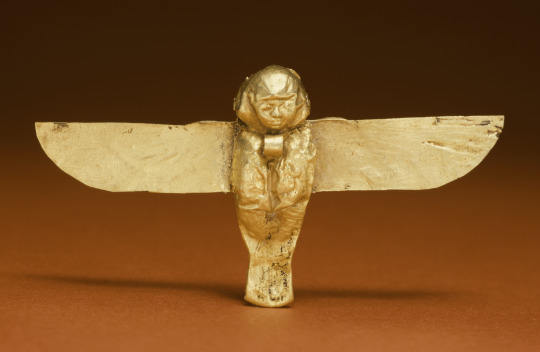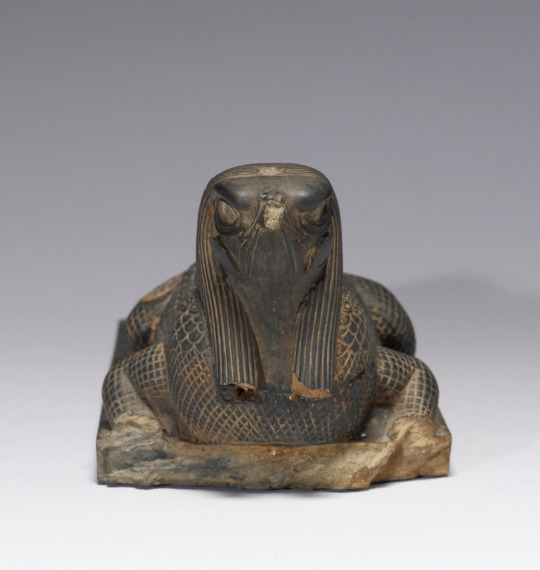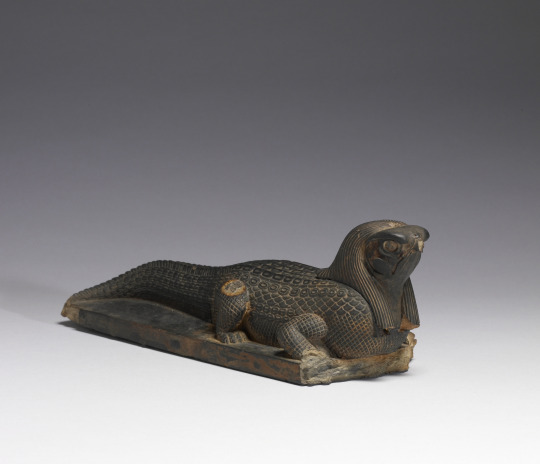#Ptolemaic art
Explore tagged Tumblr posts
Text

Ancient Egyptian faience inlay depicting a falcon with spread wings. Artist unknown; 4th cent. BCE (Late Period or early Ptolemaic). Now in the Metropolitan Museum of Art.
#art#art history#ancient art#Egypt#Ancient Egypt#Egyptian art#Ancient Egyptian art#Late Period#Ptolemaic#Ptolemaic Egypt#Ptolemaic art#animals in art#birds of prey#falcon#inlay#faience#Metropolitan Museum of Art
1K notes
·
View notes
Text

egyptian relief of lion | c. 380 - 200 BCE | egypt, early ptolemaic period
in the colleción amalita
453 notes
·
View notes
Text

~ Vignette from funerary papyrus (Book of the Dead) from papyrus N 3149.
Period: Ptolemaic Period
Medium: Papyrus
#ancient#ancient art#history#museum#archeology#ancient egypt#ancient history#archaeology#egyptian#egyptology#egypt#book of the dead#funerary art#funerary papyrus#papyrus#sistrum#hieratic#crown#atum#vignette#Ptolemaic Period
731 notes
·
View notes
Text

Head of a cat Late Period–Ptolemaic Period, c. 664–30 B.C. The Met.
#Head of a cat#Late Period–Ptolemaic Period#c. 664–30 B.C.#cat#metal#metal sculpture#ancient artifacts#archeology#archeolgst#history#history news#ancient history#ancient culture#ancient civilizations#ancient egypt#egyptian history#egyptian art#ancient art
616 notes
·
View notes
Text

Gold diadem with herakles knot, crafted in Alexandria, Egypt, 220-100 BC
2K notes
·
View notes
Text

Cleopatra
By Gustave Moreau
Watercolor Painting, c. 1887
Private Collection.
I love her nose in this painting. She's everything I want to be. She's also definitely a capricorn 👅
#im back#long time no see#aesthetic#art#artwork#painting#history#19th century#19th century painting#gustave moreau#cleopatra#royalty#ancient#ancient egypt#ancient history#watercolor#watercolor art#art blog#egypt#ptolemaic#macedonian#French#french painting#french art#french artist#victorian#third republic#belle epoque#symbolism#mystical
82 notes
·
View notes
Text

| Inlay of the god Thoth striding with the feather of Ma'at | 🪶 {Late Period-Ptolemaic period, Hermopolis, on display at the Met Museum}
#ancient egypt#ancient art#inlay#late period#ptolemaic#djehuty#thoth#egypt#egyptology#egyptian#greco roman#kemet#kemetic
100 notes
·
View notes
Text

Head of a lion, Late Period–Ptolemaic Period, 400–300 B.C.
Gypsum plaster,
H. 42.5 x W. 40 cm (16 3/4 x 15 3/4 in.)
On view at The Met Fifth Avenue
#art#history#design#style#archeology#sculpture#antiquity#head#lion#egypt#late period#ptolemaic#gypsum#plaster#the met
219 notes
·
View notes
Text

Antony and Cleopatra - art by J. C. Leyendecker (1910)
#j. c. leyendecker#antony and cleopatra#illustrations#fantasy art#william shakespeare#historical drama#theater plays#ptolemaic egypt#1910s#1910
321 notes
·
View notes
Text

Sardonyx cameo of Cleopatra VII depicted as Isis and Mark Antony as Osiris.
The image and description comes from the book called Engraved Gems which can be read for free here.
#cleopatra#cleopatra vii#mark antony#marcus antonius#roman history#ancient culture#ancient rome#cameo#ancient art#engraved gem#ancient egypt#hellenistic egypt#ptolemaic egypt
171 notes
·
View notes
Text

Ancient Egyptian depiction (gold with stone inlay) of the ba. One of the components of the multipartite soul in Egyptian thought, the ba, normally depicted as a human-headed bird, represented an individual's distinct personality. Artist unknown; early 3rd century BCE (=beginning of the Ptolemaic period). Now in the Walters Art Museum, Baltimore. Photo credit: Walters Art Museum.
#art#art history#ancient art#Egypt#Ancient Egypt#Egyptian art#Ancient Egyptian art#Egyptian religion#Ancient Egyptian religion#kemetic#Ptolemaic Egypt#Ptolemaic art#metalwork#gold#goldwork#Walters Art Museum
219 notes
·
View notes
Text

miniature portrait head, perhaps Berenike II, carved out of garnet | c. 375-325 BCE | egypt, ptolemaic
in the michael c. carlos museum collection
256 notes
·
View notes
Text



~ Statue of a Crocodile with the Head of a Falcon.
Culture: Egyptian
Date: ca. 380-250 B.C.
Period: Late Period-early Ptolemaic Period; 30th Dynasty
Medium: Steatite
#ancient#ancient art#history#museum#archeology#ancient egypt#ancient sculpture#ancient history#archaeology#Egyptian#egyptology#Egypt#crocodile#falcon#ptolemaic#late period#30th dynasty#steatite#ca. 390 b.c.#ca. 250 b.c.
3K notes
·
View notes
Text

An Egyptian Gilt Cartonnage Mummy Mask Ptolemaic Period, 304-30 B.C.
#An Egyptian Gilt Cartonnage Mummy Mask#Ptolemaic Period#304-30 B.C.#mummy mask#ancient artifacts#archeology#archeolgst#history#history news#ancient history#ancient culture#ancient civilizations#ancient egypt#egyptian history#egyptian hieroglyphs#egyptian art#ancient art
237 notes
·
View notes
Text

Ptolemaic Bronze Head of an Ethiopian. 4th-1st century BCE.
#reddit#mrdangerman#artefactporn#bronze#ptolemaic#head#ethiopian#art#4th - 1st c bce#east africa#africa#black history month
71 notes
·
View notes
Text

117 notes
·
View notes